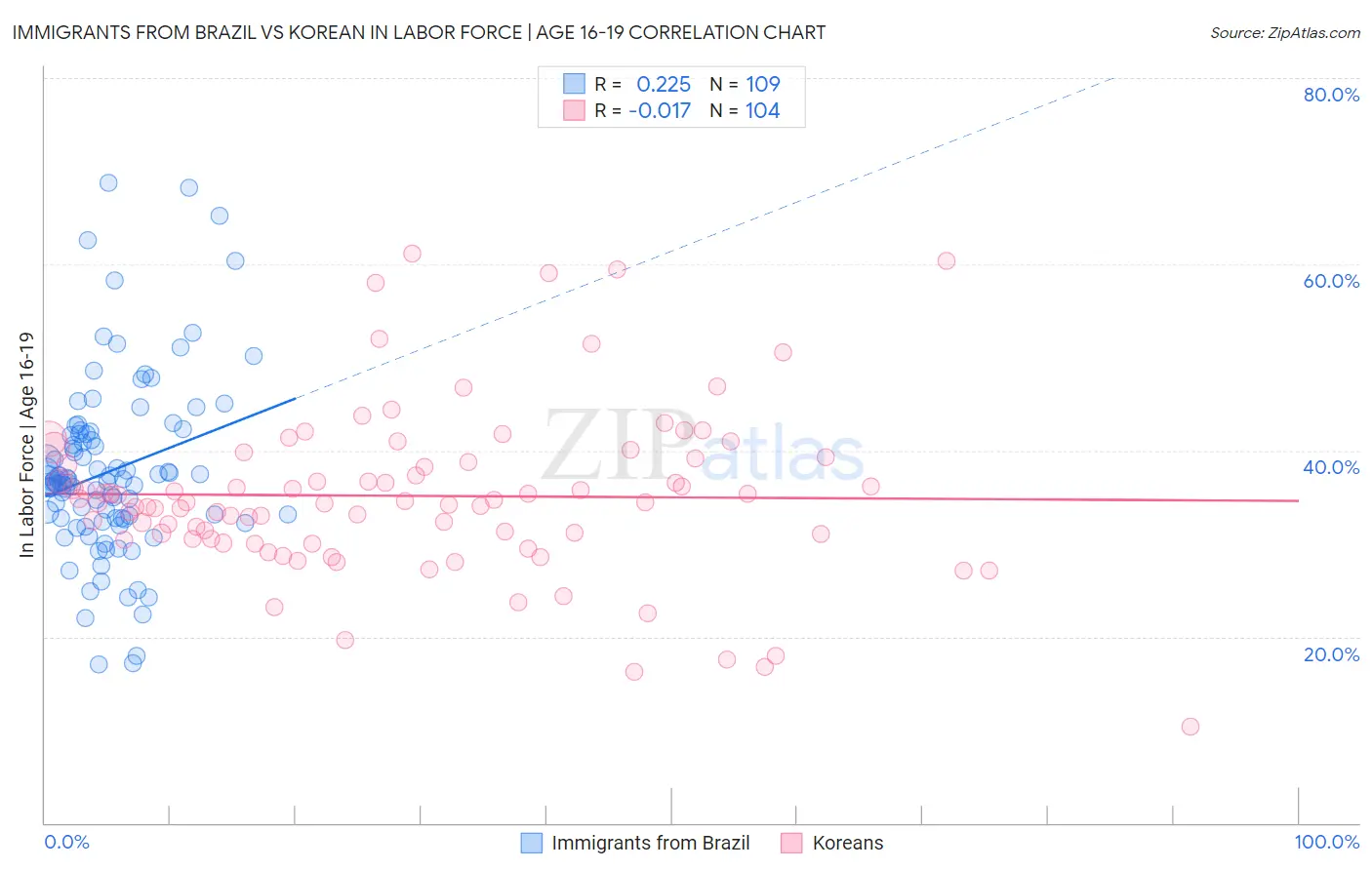Immigrants from Brazil vs Korean In Labor Force | Age 16-19
COMPARE
Immigrants from Brazil
Korean
In Labor Force | Age 16-19
In Labor Force | Age 16-19 Comparison
Immigrants from Brazil
Koreans
37.1%
IN LABOR FORCE | AGE 16-19
76.5/ 100
METRIC RATING
157th/ 347
METRIC RANK
35.7%
IN LABOR FORCE | AGE 16-19
13.3/ 100
METRIC RATING
208th/ 347
METRIC RANK
Immigrants from Brazil vs Korean In Labor Force | Age 16-19 Correlation Chart
The statistical analysis conducted on geographies consisting of 342,618,647 people shows a weak positive correlation between the proportion of Immigrants from Brazil and labor force participation rate among population between the ages 16 and 19 in the United States with a correlation coefficient (R) of 0.225 and weighted average of 37.1%. Similarly, the statistical analysis conducted on geographies consisting of 509,513,033 people shows no correlation between the proportion of Koreans and labor force participation rate among population between the ages 16 and 19 in the United States with a correlation coefficient (R) of -0.017 and weighted average of 35.7%, a difference of 3.9%.

In Labor Force | Age 16-19 Correlation Summary
| Measurement | Immigrants from Brazil | Korean |
| Minimum | 17.1% | 10.4% |
| Maximum | 68.8% | 61.1% |
| Range | 51.7% | 50.7% |
| Mean | 37.8% | 35.1% |
| Median | 36.7% | 34.4% |
| Interquartile 25% (IQ1) | 32.7% | 30.5% |
| Interquartile 75% (IQ3) | 41.8% | 39.0% |
| Interquartile Range (IQR) | 9.1% | 8.4% |
| Standard Deviation (Sample) | 9.5% | 9.0% |
| Standard Deviation (Population) | 9.5% | 8.9% |
Similar Demographics by In Labor Force | Age 16-19
Demographics Similar to Immigrants from Brazil by In Labor Force | Age 16-19
In terms of in labor force | age 16-19, the demographic groups most similar to Immigrants from Brazil are Ute (37.1%, a difference of 0.050%), Yaqui (37.1%, a difference of 0.14%), Immigrants from Saudi Arabia (37.0%, a difference of 0.17%), Kiowa (37.2%, a difference of 0.29%), and Immigrants from Lithuania (37.2%, a difference of 0.31%).
| Demographics | Rating | Rank | In Labor Force | Age 16-19 |
| Tsimshian | 84.7 /100 | #150 | Excellent 37.4% |
| Immigrants | Poland | 84.4 /100 | #151 | Excellent 37.3% |
| Immigrants | Sierra Leone | 83.6 /100 | #152 | Excellent 37.3% |
| Arapaho | 81.8 /100 | #153 | Excellent 37.3% |
| Immigrants | Bulgaria | 81.6 /100 | #154 | Excellent 37.3% |
| Immigrants | Lithuania | 80.7 /100 | #155 | Excellent 37.2% |
| Kiowa | 80.4 /100 | #156 | Excellent 37.2% |
| Immigrants | Brazil | 76.5 /100 | #157 | Good 37.1% |
| Ute | 75.7 /100 | #158 | Good 37.1% |
| Yaqui | 74.4 /100 | #159 | Good 37.1% |
| Immigrants | Saudi Arabia | 73.9 /100 | #160 | Good 37.0% |
| Cambodians | 71.5 /100 | #161 | Good 37.0% |
| Immigrants | Jordan | 69.5 /100 | #162 | Good 36.9% |
| Bermudans | 69.3 /100 | #163 | Good 36.9% |
| Immigrants | Kuwait | 68.9 /100 | #164 | Good 36.9% |
Demographics Similar to Koreans by In Labor Force | Age 16-19
In terms of in labor force | age 16-19, the demographic groups most similar to Koreans are Moroccan (35.7%, a difference of 0.070%), Immigrants from Eastern Europe (35.8%, a difference of 0.12%), South American Indian (35.8%, a difference of 0.14%), Chilean (35.8%, a difference of 0.14%), and Immigrants from Albania (35.8%, a difference of 0.17%).
| Demographics | Rating | Rank | In Labor Force | Age 16-19 |
| Alsatians | 17.5 /100 | #201 | Poor 35.9% |
| Senegalese | 17.4 /100 | #202 | Poor 35.9% |
| Immigrants | Nigeria | 16.8 /100 | #203 | Poor 35.8% |
| Immigrants | Albania | 15.0 /100 | #204 | Poor 35.8% |
| South American Indians | 14.6 /100 | #205 | Poor 35.8% |
| Chileans | 14.6 /100 | #206 | Poor 35.8% |
| Immigrants | Eastern Europe | 14.5 /100 | #207 | Poor 35.8% |
| Koreans | 13.3 /100 | #208 | Poor 35.7% |
| Moroccans | 12.7 /100 | #209 | Poor 35.7% |
| Immigrants | Switzerland | 11.9 /100 | #210 | Poor 35.6% |
| Mexicans | 11.9 /100 | #211 | Poor 35.6% |
| Houma | 11.0 /100 | #212 | Poor 35.6% |
| Immigrants | Bolivia | 11.0 /100 | #213 | Poor 35.6% |
| Apache | 11.0 /100 | #214 | Poor 35.6% |
| Immigrants | South Eastern Asia | 10.8 /100 | #215 | Poor 35.6% |